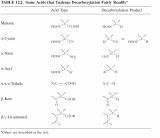
"The decarboxylation of a-amino acids can be carried out advantageously, according to Wada, through the hydantoins formed by reaction with urea. The hydantoins are hydrolyzed by concentrated alkalies or acids to form carbon dioxide and ammonia; thus, the basic primary amines are obtained in good yields according to the reaction:
R*CH(NH2)*COOH + H2N*CO*NH2 --> H2N*CO*NH*CHR*COOH ---> R[ring](CH-NH-CO-NH-CO] + H2O ---> R*CH2*NH2 + 2CO2 + NH3
10 g of phenylalanine are boiled under a reflux for 35 minutes with an excess of urea (5 g) in 150 ml of water. The uramido acid thus formed is converted to the hydantoin by evaporation to dryness with hydrochloric acid and the dry residue is dessolved in ether. The hydantoin crystallizes from the ether upon concentration. The product (4.9 g) is refluxed for 10 hours with 70 ml of water and 20 ml of concentrated sulfuric acid. The solution is then made alkaline and extracted with ether. There are thus obtained 2.5 g of phenethylamine (80% of the theoretical amount) boiling at 189C.
In place of urea, urethane, potassium cyanate, or phenyl isocyanate in neutral or alkaline solution may be used. Uramido acids or their salts are formed and these with dilute acids yield the hydantoins. Wada describes the decarboxylation of glycine, leucine, lysine, tyrosine, proline, tryptophan, arginine, cystine, aspartic acid and glutamic acid."
A more efficient method of preparing the amino acid hydantoin would be useful, if anybody knows of such.

 lol !
lol !
